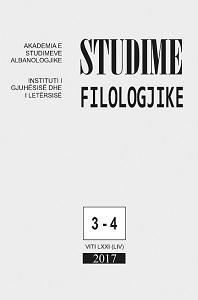Lokucione të ndërmjetme me strukturë togfjalëshe në gjuhën shqipe
Intermediary Locution in Albanian Language
Author(s): Haredin XhaferiSubject(s): Language studies, Theoretical Linguistics, Syntax, Lexis, Semantics
Published by: Qendra e Studimeve Albanologjike
Keywords: Albanian language; intermediary locution; syntactic functions; semantic;
Summary/Abstract: Intermediary locutions are groups of words or sustainable units of togfjalësh that do not perform syntactic functions as sentence constituents. Just as for locutions of other groups, for these types of locutions there aren’t any specific studies. They are treated by M. Çeliku as intermediary words and intermediary groups of word. These locutions are different from the structure and the meaning. From the structure they are togfjalësh or not togfjalësh in the linguistic meaning of the term togfjalësh. There are fewer intermediary locutions compared to those with non togfjalësh structure. Even their structural types are fewer. Their structure is formed by two, three or more marker words and functional words. Each word that participates in the structure of these locutions has lost its individual meaning and its individual syntactical function and the entire unit operates as a single entity with a single meaning. Marker words are connected between them with the characteristic connection of compound words. I. The locutions formed by two words have in their structure two marker words (nouns): fundi i fjalës, fundi i fundit etc. II. The locutions with more than two words have in structure a functional word. The functional words are prepositions or particles. 1. The locutions formed by a preposition and two marker words constitute a relatively large number. For example: nga njëra anë, nga ana ime, me pak fjalë, me gjithë mend, në radhë të parë, për sytë e ballit, pa pikë dyshimi, sipas mendimit tim, etc. 2. The locutions formed by a particle and two marker words are just a few: aq më tepër, aq më shumë, ca më pak, etc. In conclusion I can say that the intermediary locutions find use in communication. Their elements, although formally retain the subordinate connection, function as a single unit, with a specific meaning. As and locutions of the other groups, these locutions present linguistic interest for further study.
Journal: Studime Filologjike
- Issue Year: 2017
- Issue No: 03-04
- Page Range: 133-140
- Page Count: 8
- Language: Albanian

